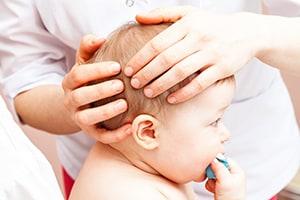Help Center
Online Resource Center for Information on Birth Injuries.

Craniosacral therapy (CST) is newly development treatment method that can help newborn infants who suffer head injury or trauma during childbirth. Studies have shown that craniosacral therapy can have significant therapeutic benefits for babies with birth injuries involving the head such as cephalohematoma, caput succedaneum, or hydrocephalus. CST can also be effective at dealing with other non-injury related problems many newborn infants experience, including things like colic, feeding problems, and irritability.
Craniosacral therapy (also called cranial sacral therapy) is a type of medical massage therapy that releases tension and compression in the cranial bones of the head, and the sacrum bone in the lower back. CST uses gentle hand-pressure techniques to manipulate these bones and surrounding tissue in the skull and lower back.
This has been shown to improve the circulation and flow of cerebrospinal fluid by removing blockages and stimulating nerves. Increased spinal fluid circulation can help regulate and normalize a baby’s central nervous system. This enhances their ability to heal and speeds in the recovery of various types of head injuries associated with traumatic childbirth.
Trauma or injury to a baby’s head is a very common consequence of the childbirth process. Injuries to the head are the most common type of birth-related trauma. Most birth-related head injuries are relatively minor, but some can be more serious and involve brain damage.
The reason head injuries are so common in childbirth is because of the tremendous pressure the baby’s head is subjected to during a typical vaginal delivery. The baby’s head is the largest part of its body. At birth, the bones in a baby’s skull are not fully fused together. This enables the baby’s head to be flexible and to naturally compress as it gets squeezed through the birth canal.
This amazing feature of biology makes human childbirth possible. However, it also makes the baby’s head and precious brain very vulnerable to external force during delivery. If the infant’s head is subjected to excessive force during childbirth, the flexibility of the skull bones can expose it to trauma. Even small amounts of excess pressure or force can result in trauma to the infant’s head.
When a baby suffers trauma or damage to the head during childbirth it is usually not serious. Most common types of newborn head-trauma are fairly benign and don’t cause any long-term health impacts. For instance, cephalohematoma is a common head injury in newborns that results in small pool of blood under the scalp. Cephalohematomas typically resolve on their own within a few weeks after birth. Caput succedaneum is another common neonatal head injury with an even more favorable prognosis.
Even though most infant head injuries have favorable outcomes, they can still cause a lot of problems and frustration for parents and babies. Even mild head trauma can cause tension and disrupt a baby’s nervous system. This can lead to all sorts of issues such as irritability, colic, and feeding difficulties.
Craniosacral therapy has a host of benefits for newborns who suffer head trauma during delivery. CST therapy helps to normalize the baby’s central nervous system. Infants with head trauma often have issues with poor spinal fluid circulation. The manipulation and stimulation of the bones and tissue in the baby’s head and lower back can greatly improve the flow of cerebrospinal fluid. This helps calm and sooth the baby and eliminate many newborn problems.
Studies have also found that CST helps head injuries and trauma in newborn infants heal much faster. When regular CST is received in the first weeks of the baby’s life, their recovery and healing time for head trauma can increase by as much as 40%. Mild head trauma in newborns can sometimes lead to secondary complications if it does not heal quickly, so using CST to speed up recovery helps to decrease the risk of these more serious complications.
CST has also proven to be a very effective treatment for newborns with feeding difficulties. Many feeding problems in newborns occur when the baby is not able to open their mouth enough to “latch on” to the mother’s nipples. CST can improve this problem by eliminating the tension and stiffness in the baby’s oral reflexes, neck, and shoulders. A number of recent studies have demonstrated the effectiveness of
CST is resolving feeding problems caused by motor impairments in infants.
A CST session is sort of like a baby massage. The infant is either placed on a special pediatric massage table (or in some cases held in a parent’s lap). Various techniques are then applied to relax and calm the baby. Once the baby is calm, the CST therapist performs a series of repeated massage techniques with their hands. The massaging targets very specific areas and bones in the baby’s body (the skull, jaw, temples, and lower back).
No. CST is not painful or uncomfortable for babies. In fact, CST is like a relaxing baby massage that is usually very enjoyable. It consists of gentle hand massaging at certain specific points on the baby’s body.
Many pediatricians are trained in CST techniques and are able to perform it, however, CST is generally done by a pediatric physical therapist, a nurse, or a licensed massage therapist with CST training.